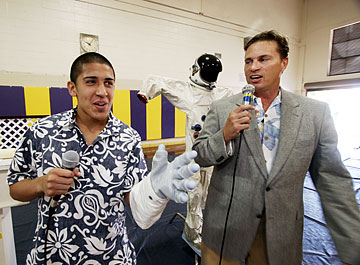
DENNIS ODA / DODA@STARBULLETIN.COM
Chris Davis, a 1973 Damien graduate and NASA engineer, presented Damien students yesterday with tiles removed from space shuttle Columbia. Davis aided the investigation of the 2003 Columbia tragedy and helped devise better shuttle protection. Student Kris Herauf tried on a glove that astronauts use.
|
|
Role model is out of this world
Damien grad Chris Davis hopes to interest youths in space work
A NASA senior project manager yesterday presented students at Damien Memorial School with a tile from the space shuttle Columbia, hoping to inspire youngsters to play key roles in America's pursuit to inhabit the moon by 2020.
Chris Davis, an engineer for the National Aeronautics and Space Administration and a 1973 Damien graduate who also attended the University of Hawaii, helped investigate the Columbia disaster that killed seven astronauts on Feb. 1, 2003. He also led the team that solved the problem and helped launch the shuttle Discovery mission in July 2005, which ended the 2- 1/2-year grounding of the shuttle program.
Along with many others at the Kennedy Space Center in Florida, he is working at a "feverish pace" to prepare for the July 1 launch of Discovery's next mission, when the shuttle will carry supplies to the International Space Station. This will be Discovery's 28th mission.
Matched by its serial number to space shuttle Columbia, the tile was removed in 1997 during maintenance. It is made of silica and was designed to shield astronauts from the heat of re-entry into the Earth's atmosphere, when temperatures soar to 2,500 degrees Fahrenheit.
Davis also brought with him a piece of the shuttle's foam -- part of the insulation that prevents ice formation on the external fuel tank. If ice forms, it could harm the orbiter's tiles and cause a tragedy similar to the one that occurred three years ago.
In 2003, a large piece of foam broke off during Columbia's launch. It pierced the tiles, which allowed heat to penetrate during re-entry, incinerating the $3 billion orbiter. Since then, the U.S. government has spent an estimated $10 million to $20 million to investigate design flaws to learn as much as possible before the shuttle program ends in 2010 to make way for the next step in space reconnaissance.
NASA plans to begin launches associated with the Constellation Program in 2012. Fundamental goals include inhabiting the moon, about 250,000 miles from Earth, and Mars, 34 million miles away. "These are very big steps toward exploring our solar system and beyond," said Davis, who is also involved with NASA's Constellation Program.
The Space Shuttle Program has laid the groundwork for scouting the possibilities of extended life beyond Earth. Before the program ends, researchers hope to complete construction of the International Space Station, perfect the use of reusable engines and better understand the biological effects on humans living in space for long periods.
Davis spoke to Damien students earlier in the week, but returned because he wanted to leave them with something tangible. He hopes they'll understand that the opportunity to work in such a vast and mysterious area of science is open to anyone. "To get students to appreciate and maybe have an interest in space technology begins with letting them experiment with the materials," said Davis, who worked in Damien's school cafeteria to help pay his tuition.
Also on display during the school assembly was the space suit Allan Bean wore in training for the Apollo 12 moon mission. In 1969, Bean became the fourth man to walk on the moon.
Because NASA never parts with its materials, the tile will remain at Damien on "indefinite loan."

